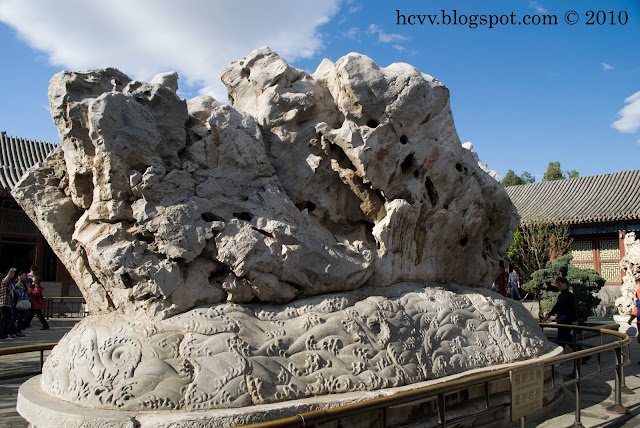Here's the finale of the Summer Palace. Loaded with more photos and captions. In this posting we will be heading to the 17 Arch Bridge as well as some pavilion and the chance to see the statue of Dragon King.
Another Suzhou road on the way to the bridge..it's a long walk to that bridge unless you want to take a boat ride..but it was very windy that day.
And on the way I came across one of the Emperor's hall..well this photo was taken from outside..no one is allowed to get inside. This hall is called The Hall of Jade Ripples (Yulan Tang). These area were living quarters for Emperor Guangxu.This room was used to read submissions to the throne and conduct court affairs in the central room. These table was made from red sandalwood inlaid with eaglewood, glass screens decorated with landscape paintings, and fans made with emerald green feathers - which are the symbols of imperial power.
and this is Wenchang Tower (Wenchang Ge) the largest of of the six gate forts in the Summer Palace garden. It was first built in the year 1750 and rebuilt under the Emperor Guangxu after it was burned down by the Anglo-French Allied Forces burned down in 1860. A bronze statue of the god, Wenchang, and statues of two followers, the celestial boy, and the bronze steed, were placed in the double story pavilion.
This is the Zhichun Ting (Heralding Spring Pavilion) This small pavilion was built on a small island in front of the Hall of Jade Ripples, beside Kunming Lake's east bank. With good feng shui, the pavilion backs on a hill and to the South it faces the Sun. This position permits a privilege view of Spring's arrival and provides the best overall view of Longevity Lake and Kunming Lake.
Strong wind around the Kunming Lake..
A view of the temple from the pavillion
The 17 Arch Bridge
The Seventeen-Arch Bridge (十七孔桥) was built in the 1750 during the Emperor Qianlong's reign. This 150m meter long bridge links the East Bank and South Lake Island. It is the longest bridge in any Imperial Chinese garden. Over 50 stone lions in different positions and poses were carved on the posts of the bridge railings.
across the bridge you will be able the statue of the Dragon King
A beautiful view from the 17 arch bridge
The Bronze Ox (同牛) was cast during the Emperor Qianlong's reign. As it looks like a lifelike bearing, it was placed here and was said to control floods. The eighty word ode entitled "Inscriptions on the Golden Ox" was written by Emperor Qianlong in traditional "seal" style calligraphy

The seal style calligraphy by Emperor Qianlong..anyone knows how to read and interpret this?
That's the end of the 4 Summer Palace Series..hope you enjoy this posting
For those who have missed the previous 3 series, you can check it out by clicking on the links below:




















































.JPG)


